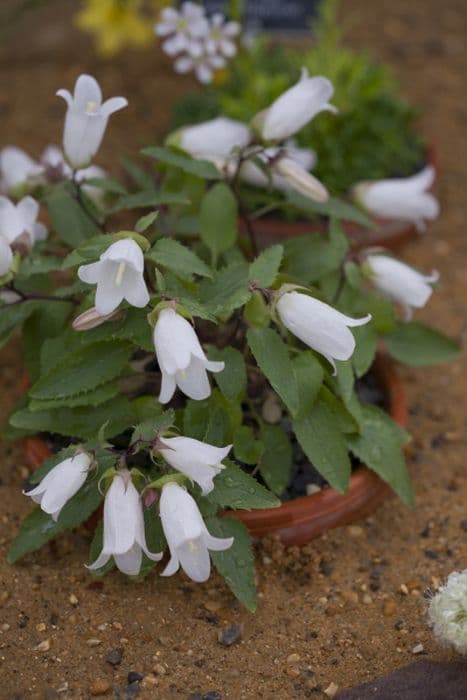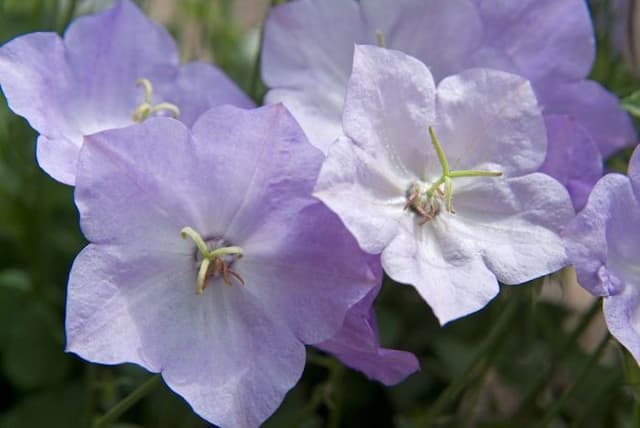Hybrid Lobelia Lobelia × speciosa 'Pink Elephant'

ABOUT
The Lobelia × speciosa 'Pink Elephant' is a striking flowering plant known for its striking blooms. This perennial boasts vibrant pink flowers, which have a tubular shape with open ends, resembling little trumpets or horns that cluster densely at the top of sturdy upright stems. The blooms are a soft yet bright shade of pink, offering a gentle but lively pop of color to any garden setting. The leaves of 'Pink Elephant' are deep green, often with a hint of bronze, and they have a slightly toothed or serrated edge. The foliage forms a mound-like base from which the flower spikes emerge, offering a lush backdrop for the pink floral display. The overall impression of the 'Pink Elephant' is one of robustness and vivid, lasting color, bringing a whimsical elegance and attracting pollinators to the garden without overwhelming it with size.
About this plant
 Names
NamesFamily
Campanulaceae
Synonyms
Pink Elephant Hybrid Lobelia, Pink Elephant Cardinal Flower
Common names
Lobelia × speciosa 'Pink Elephant'
 Toxicity
ToxicityTo humans
The Lobelia, specifically Lobelia × speciosa 'Pink Elephant', contains several alkaloids, such as lobeline, that can be toxic when ingested in significant quantities. If humans consume parts of this plant, they may experience symptoms such as nausea, vomiting, diarrhea, cough, dizziness, tremors, and an elevated heart rate. In severe cases, more profound central nervous system effects such as convulsions and coma can occur. It is important to seek medical attention if ingestion is suspected.
To pets
Lobelia is also toxic to pets due to the same alkaloids that affect humans. If a pet ingests parts of this plant, symptoms can include excessive salivation, vomiting, diarrhea, abdominal pain, difficulty breathing, lethargy, and seizures. In severe cases, ingestion of Lobelia can lead to a potentially fatal drop in blood pressure or coma. Immediate veterinary care is crucial if a pet is suspected to have consumed any part of the Lobelia plant.
 Characteristics
CharacteristicsLife cycle
Perennials
Foliage type
Deciduous
Color of leaves
Green
Flower color
Pink
Height
2-3 feet (60-90 cm)
Spread
1-2 feet (30-60 cm)
Plant type
Herb
Hardiness zones
6
Native area
NA
Benefits
 General Benefits
General Benefits- Attracts pollinators: The flower attracts bees, butterflies, and hummingbirds, aiding in pollination and supporting the local ecosystem.
- Decorative appeal: With its striking pink flowers, 'Pink Elephant' adds color and visual interest to gardens and landscapes.
- Drought tolerance: Once established, this variety of lobelia can tolerate periods of drought, making it suitable for xeriscaping.
- Easy to grow: 'Pink Elephant' is known for being easy to cultivate, requiring minimal maintenance and care.
- Long blooming season: This plant offers a long flowering period, providing continuous color from early summer to fall.
- Adaptability: It can adapt to a variety of soil conditions, although it prefers moist, well-drained soils.
- Compact size: Its compact growth habit makes it an ideal choice for containers, borders, or small garden spaces.
- Cold hardiness: 'Pink Elephant' exhibits a degree of cold resistance, allowing it to withstand cooler temperatures and making it suitable for a variety of climates.
 Medical Properties
Medical PropertiesThis plant is not used for medical purposes.
 Air-purifying Qualities
Air-purifying QualitiesThis plant is not specifically known for air purifying qualities.
 Other Uses
Other Uses- Lobelia × speciosa 'Pink Elephant', commonly known as Lobelia, can be used in art projects for its vibrant pink flowers that provide a striking natural pigment for dyes or inks.
- The plant's unique flower structure can inspire patterns and designs in fashion, such as textile prints or jewelry where its form is replicated or abstracted.
- Due to its robust nature, Lobelia can be used in educational settings such as school gardens to teach children about plant growth and pollination.
- The stems and leaves of the Lobelia can be used in crafting, such as in the creation of natural wreaths or as an addition to floral arrangements.
- Lobelia can be planted in rain gardens as it can tolerate moist soil conditions, helping in water management and soil erosion control.
- Photographers and artists might use the Lobelia as a subject for practicing close-up shots or still life paintings, capturing its vivid colors and textures.
- Gardeners may use this plant as a border to define walkways or garden paths due to its dense and spreading growth habit.
- With its attractive blooms, Lobelia is suitable for decorating outdoor events and ceremonies by incorporating them into the venue’s landscape.
- In culinary uses, the vibrant petals of the Lobelia could be used as a colorful garnish for salads, although it’s essential to ensure they are free from pesticides and are safe for consumption.
- Its ability to attract pollinators like butterflies and hummingbirds can be used to foster a supportive ecosystem for these creatures in a garden setting.
Interesting Facts
 Feng Shui
Feng ShuiThe Lobelia is not used in Feng Shui practice.
 Zodiac Sign Compitability
Zodiac Sign CompitabilityThe Lobelia is not used in astrology practice.
 Plant Symbolism
Plant Symbolism- Uniqueness: The 'Pink Elephant' variety of Lobelia is not as common as its blue or purple relatives, symbolizing the uniqueness and rarity in its pink bloom.
- Distinction: With its standout color, the plant embodies distinction, making it a symbol for standing out in a crowd or being distinctive.
- Attraction: The Lobelia's bright, attractive flowers can symbolize an irresistible charm and the ability to attract attention in a positive way.
- Healing: Traditionally, lobelias have been used for medicinal purposes, which translates symbolically into healing and relief.
- Communication: As lobelias are also known for their use in herbal remedies to help with respiratory issues, they can be seen as a symbol of clear communication and expression.
 Water
WaterCardinal flowers should be watered regularly, aiming to keep the soil evenly moist but not waterlogged. During hot summer months, this may mean watering deeply once every 2-3 days, depending on rainfall and soil drainage. In general, providing about 1 inch of water weekly, either through rainfall or manual watering, is sufficient. Adjustments should be made based on temperature, climate, and specific growing conditions. Ensure the water is applied directly to the base of the plant to reduce the risk of leaf diseases.
 Light
LightCardinal flowers thrive in full sun to partial shade. The ideal spot for growing Lobelia × speciosa 'Pink Elephant' would be where it receives morning sunlight and afternoon shade, especially in hotter climates. Areas with too much shade may cause the plant to have fewer flowers and a leggy growth pattern.
 Temperature
TemperatureCardinal flowers prefer moderate temperatures and will perform well in a range typical for many garden environments. They can typically withstand minimum temperatures down to about 20 degrees Fahrenheit and are comfortable up to around 90 degrees Fahrenheit. The ideal temperature range for optimal growth is between 60 and 70 degrees Fahrenheit.
 Pruning
PruningPruning cardinal flowers involves deadheading spent blooms to encourage further flowering throughout the season. Additionally, cut back the entire plant by about one-third after the first wave of flowering is done to rejuvenate it for additional blooms. Pruning is best done in late winter or early spring before new growth starts.
 Cleaning
CleaningAs needed
 Soil
SoilThe Fan Lobelia thrives in moist, well-draining soil with rich organic matter. A mix of loamy soil, peat moss, and perlite or sand can create a suitable environment for this hybrid lobelia, while maintaining a slightly acidic to neutral pH of 6.0 to 7.0 is optimal.
 Repotting
RepottingFan Lobelia does not often require repotting as it is typically grown as an annual; however, if grown as a perennial, repotting every 2-3 years or when rootbound is sufficient.
 Humidity & Misting
Humidity & MistingFan Lobelia prefers moderate to high humidity levels. Ideal humidity for this plant ranges from 40% to 70%, which promotes lush growth and vibrant blooms.
 Suitable locations
Suitable locationsIndoor
Place Fan Lobelia near a window with bright, indirect light and maintain moisture.
Outdoor
Plant Fan Lobelia in partial shade with moist, rich soil, and mulch.
Hardiness zone
6-9 USDA
 Life cycle
Life cycleThe Lobelia × speciosa 'Pink Elephant', commonly known as the hybrid lobelia or Pink Elephant lobelia, begins its life cycle with seed germination, which typically occurs in warm, moist soil conditions in the spring. After germination, the seedlings develop into young plants with characteristic foliage, initiating the vegetative growth stage. As the plants mature during their first or second growing season, they enter the flowering stage, producing tall spikes with numerous vibrant pink flowers that attract pollinators. Following the flowering phase, the plant sets seed, encased in small capsules, which disperse when mature, completing the reproductive cycle. In regions with colder climates, hybrid lobelia behaves as a perennial, dying back to the ground with the onset of winter but regenerating from the root system when conditions improve in the subsequent growing season. If conditions are not suitable for overwintering, the plant may be treated as an annual, completing its life cycle within one growing season before succumbing to frost.
 Propogation
PropogationPropogation time
Spring to Summer
The Lobelia × speciosa 'Pink Elephant', commonly known as the hybrid Lobelia or Fan Lobelia, is typically propagated through seed sowing. To propagate by seed, it is best done in late winter or early spring to allow for a full growing season. Seeds should be sown in a tray filled with a well-drained seed starting mix, lightly covered with soil as they need light to germinate. The tray must be kept at a temperature of around 70°F (21°C), and the soil should be kept moist but not waterlogged. Germination usually occurs within 2 to 3 weeks. When seedlings are large enough to handle, they can be transplanted into individual pots and then later moved to their final location in the garden after the danger of frost has passed.









![Milky bellflower [Avalanche]](/_next/image?url=https%3A%2F%2Fplants-admin.emdemapps.com%2Fimages%2Fplants%2F%2Fimages%2F604b5dc88c1e7.png&w=640&q=75)